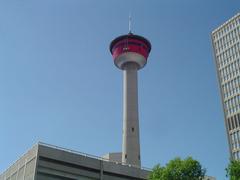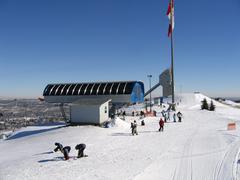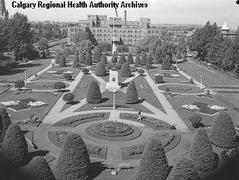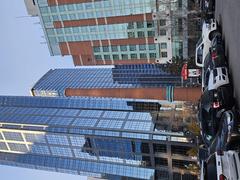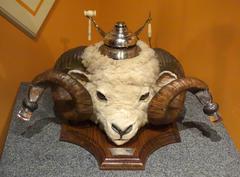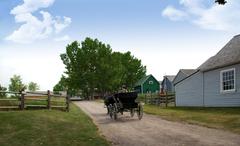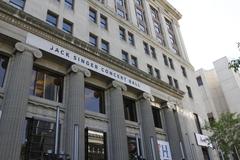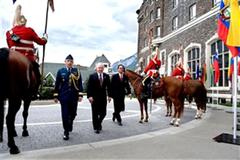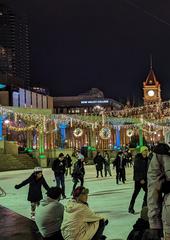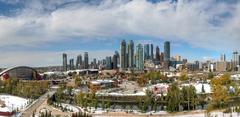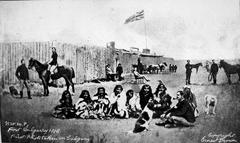
Burns Building Calgary: Visiting Hours, Tickets, and Historical Sites Guide
Date: 04/07/2025
Introduction
Located in the heart of downtown Calgary, the Burns Building stands as a distinguished emblem of the city’s early 20th-century growth, architectural ambition, and enduring cultural heritage. Commissioned by Senator Patrick (Pat) Burns—one of the “Big Four” founders of the Calgary Stampede and a pillar of Alberta’s cattle industry—the building was constructed between 1911 and 1913, during a period of rapid urban transformation. Today, it is celebrated for its Edwardian Classical and Chicago School architectural influences, ornate terra cotta facades, and a lasting role in Calgary’s historic and cultural district (LatLong.net; Archiseek).
Not merely an architectural icon, the Burns Building also reflects Calgary’s resilience and dedication to heritage preservation. Its sandstone and terra cotta construction represents the city’s “Sandstone City” era—a response to the devastating fires that shaped Calgary’s distinctive architectural identity. Over the years, the building has adapted to house commercial enterprises and offices, anchoring Calgary’s historic Stephen Avenue Walk and serving as a neighbor to landmarks such as Olympic Plaza and Calgary Central Library (REP Calgary Homes; Everyday Tourist).
This detailed visitor guide covers the Burns Building’s history, architectural features, visiting hours, ticket information, accessibility, nearby attractions, and practical travel tips, offering everything you need for a memorable visit (Visit Calgary).
Contents
- Origins and Construction
- Architectural Significance & Features
- Role in Calgary’s Urban Development
- Heritage Designation & Preservation
- Visiting the Burns Building: Hours, Tickets, and Accessibility
- Nearby Attractions and Travel Tips
- Visitor Experience & Architectural Appreciation
- Renovations and Preservation Efforts
- Visuals and Media Resources
- Frequently Asked Questions (FAQ)
- Summary and Recommendations
- References & Useful Links
1. Origins and Construction
The Burns Building was conceived as a testament to Calgary’s early 20th-century ambition. Commissioned by Pat Burns, a prominent businessman and one of the city’s most influential founders, the building was constructed between 1911 and 1913 by the architectural firm Hodgson, Bates, and Beattie. Burns intended it as both a commercial enterprise and a symbol of prosperity, with the ground floor originally housing his flagship meat market (LatLong.net; Everyday Tourist).
2. Architectural Significance & Features
Architectural Style and Influences
The Burns Building is a prime example of Edwardian Classical architecture in Western Canada, with strong influences from the Chicago School. Its exterior features ornate stonework, arched windows, and decorative cornices, all constructed from locally quarried sandstone and glazed ceramic terra cotta (Archiseek; Develop District). The use of reinforced concrete framing was innovative for its time, allowing for large windows and superior fire resistance.
Notable Features
- Facade: Clad in cream-colored terra cotta tiles, with lions’ heads and other sculptural motifs.
- Entrances: The main entrance at 237 8 Avenue SE is framed by classical pilasters and decorative moldings.
- Interior: Features white and green Italian marble in stairways and corridors, as well as a grand 130-foot market hall originally supported by Doric marble columns (Wikipedia).
- Modern Conveniences: Early adoption of electric and gas lighting, steam heating, and ventilated office spaces.
3. Role in Calgary’s Urban Development
The Burns Building’s construction marked a turning point for downtown Calgary, helping to anchor the city’s commercial activity along 8th Avenue (now Stephen Avenue Walk). Its proximity to City Hall, Olympic Plaza, and what became the civic and cultural district established its significance within the urban core (REP Calgary Homes). The building set a precedent for large-scale commercial architecture in the region.
4. Heritage Designation & Preservation
Despite changing ownership and economic challenges, the Burns Building remained a fixture in downtown Calgary. In the late 1970s and early 1980s, it narrowly escaped demolition due to a successful preservation campaign. Subsequently, it was designated a Provincial Heritage Resource in 1987, protecting its key architectural elements and ensuring its continued role in the city (LatLong.net; Develop District).
5. Visiting the Burns Building: Hours, Tickets, and Accessibility
- Hours: Public access to the building’s ground floor and common areas is typically Monday to Friday, 8:00 AM – 6:00 PM. Hours may vary by tenant or during special events (Visit Calgary).
- Tickets: No admission fee is required for casual visits. Guided tours of Calgary’s historical district, including the Burns Building, may be available through local operators and may require a fee (GPSmyCity).
- Accessibility: The building is wheelchair accessible via ramps and elevators. Visitors with specific needs should contact building management or tour providers in advance.
- Tours: Interior tours are limited, but the building is featured on heritage walking tours of downtown Calgary.
6. Nearby Attractions and Travel Tips
Key Nearby Sites
- Olympic Plaza: A popular gathering place and event venue directly across from the Burns Building.
- Calgary Central Library: A modern architectural icon within walking distance.
- Stephen Avenue Walk: Lined with heritage buildings, shops, and restaurants.
- Arts Commons & Martha Cohen Theatre: Major cultural centers nearby.
Travel Tips
- Getting There: The City Hall CTrain station is just steps away, and several bus routes serve the area (Google Maps).
- Parking: Paid lots and parkades are available, but public transit is recommended.
- Dining: The ground floor and surrounding area offer a variety of restaurants and cafes, many in other historic buildings (My Global Viewpoint).
7. Visitor Experience & Architectural Appreciation
Visitors can appreciate the Burns Building’s grandeur from Olympic Plaza or along Stephen Avenue. Guided and self-guided walking tours are available and provide historical context and architectural highlights (GPSmyCity). Architectural enthusiasts should look for the terra cotta ornamentation, marble columns, and the grand cornice—features best seen in morning or late afternoon light.
8. Renovations and Preservation Efforts
The 1980s restoration, led by A.J. Diamond and Partners with Carruthers and McCullum, preserved the building’s essential features while modernizing its systems. The project was instrumental in sparking further interest in Calgary’s architectural conservation (Develop District; Wikipedia).
9. Visuals and Media Resources
High-quality images of the Burns Building’s exterior and interior can be found on Calgary heritage websites and tourism platforms. Interactive maps and virtual tours may also be available online to help plan your visit (Waymarking).
10. Frequently Asked Questions (FAQ)
Q: What are the Burns Building visiting hours?
A: Public access is typically Monday to Friday, 8:00 AM to 6:00 PM; hours may vary.
Q: Is there an admission fee or tickets required?
A: No, visiting public areas is free; guided tours may require tickets.
Q: Is the Burns Building wheelchair accessible?
A: Yes, via the main entrance and elevators.
Q: Are guided tours available?
A: Yes, the building is included in some local heritage walking tours.
Q: Can I take photos inside the Burns Building?
A: Exterior photography is encouraged. Interior photography may be restricted; check posted signage.
11. Summary and Recommendations
The Burns Building is a cornerstone of Calgary’s historical and architectural identity, blending Edwardian Classical and Chicago School design with innovative early 20th-century construction. Its preservation and current role as a commercial and cultural hub reflect the city’s commitment to honoring its past while fostering a vibrant present. Visitors are encouraged to explore the building during business hours, enjoy nearby attractions, and take part in walking tours for deeper historical insight. Download the Audiala app for guided tours, audio commentary, and current event information to enhance your experience.
12. References & Useful Links
- Burns Building Calgary: Visiting Hours, Tickets, and Historical Insights (LatLong.net)
- Burns Building Calgary: Heritage Landmark (Archiseek)
- Burns Building Calgary: Project Details (Develop District)
- Burns Building Calgary (Wikipedia)
- Guide to Calgary’s Landmarks and Historical Buildings (REP Calgary Homes)
- Calgary Historical Buildings (Everyday Tourist)
- Visit Calgary – Official Tourism Website
- Burns Building Calgary: Historical Guide (Waymarking)
- Things to Do in Calgary (The Broke Backpacker)
- Best Things to Do in Downtown Calgary (My Global Viewpoint)
- Calgary Tower – Visitor Info (Voyage Tips)
- Glenbow Museum (PlanetWare)
- Doors Open Calgary
- Google Maps Location

